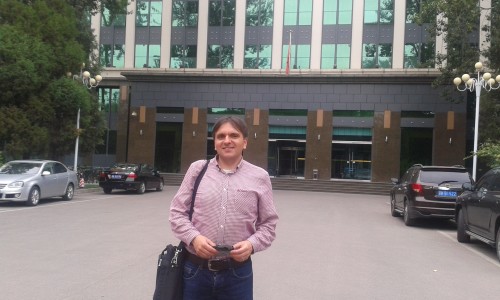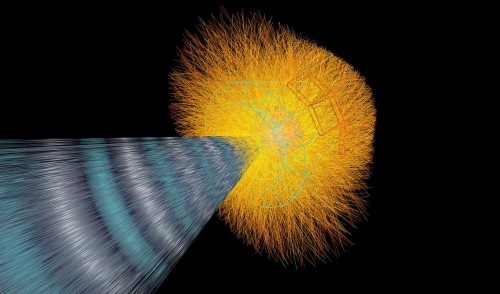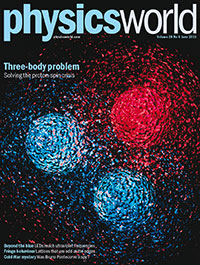Tag archives: particle physics
In flight around the world’s brightest laser and the inverse Cheerio effect
By Tushna Commissariat
If you have never been one of the lucky few to have wandered the tunnels of a particle accelerator, but have always wondered what lies within, take a look at the video above. The European X-ray Free Electron Laser (European XFEL) – which is currently under construction in Germany and will come online next year – will provide ultrashort (27,000 X-ray flashes per second) and ultrabright X-ray laser flashes that are needed to study chemical reactions in situ or to study extreme states of matter (you can read more about the kind of research that will be done there in the September issue of Physics World magazine). The XFEL tunnel is 3.4 km long and you can zoom across all of it in the 5 minute long video. I particularly enjoyed watching particular locations where engineers could be seen carrying out tests, as well as watching folks on bicycles wobble out of the camera’s way.
On a slightly related note, if, like me, you occasionally get a bit muddled when it comes to certain details of different particle accelerators – for example which came first, the synchrotron or the cyclotron – take a look at this excellent “primer” over at Symmetry magazine.
View all posts by this author | View this author's profile
China eyes new high-energy collider

Matin Durrani outside the Institute of High Energy Physics in Beijing before interviewing Xinchou Lou.
By Matin Durrani in Beijing, China
I had just landed in Beijing this morning when I saw an e-mail from my colleague Mingfang Lu waiting for me on my phone. Mingfang, who’s editor-in-chief at the Beijing office of the Institute of Physics, which publishes Physics World, has been helping me to organize my itinerary for the next week as I gather material for our upcoming special report on physics in China. You may remember we published a Physics World special report on China in 2011 but so much has happened since then that we felt it’s easily time for another.
Mingfang’s e-mail was to say we would be off at 2.30 p.m. to interview Xinchou Lou, a particle physicist at the Institute of High Energy Physics, about the country’s ambitious plans for a “Higgs factory”. If built, this 240 GeV Circular Electron–Positron Collider (CEPC) would be a huge facility (50 km or possibly even 100 km in circumference) that will let physicists study the properties of the Higgs boson in detail. I say “if”, but knowing China’s frenetic progress in physics, it will almost certainly be a case of “when”.
View all posts by this author | View this author's profile
Fractals and infinite curves, sonified data and farewell to Sir Tom Kibble
By Tushna Commissariat
Fractals have always fascinated me and I am sure it’s the same for many of you. What I find most intriguing about them is how the relatively simple base pattern, or “seed”, quickly scales up to form the intricate designs we see in a snowflake or a coastline. In the video above, mathematician and animator Grant Sanderson has created a montage of “space filling curves” – theoretically speaking, such curves can endlessly expand without every crossing its own path to fill an infinite space. Following on from these curves, Sanderson shows you just how a simple seed pattern grows into a fractal and also describes how small changes to a seed property – such as an angle in a V – can alter the final image. The above video follows from a previous one Sanderson created on “Hilbert’s curve, and the usefulness of infinite results in a finite world” so check them both out.
View all posts by this author | View this author's profile
The most expensive object on Earth, publish or perish, and a physics Magna Carta

Gold coast: the Hinkley Point C power station will be built next to existing reactors in Somerset. (CC BY-SA 2.0 Richard Baker)
By Hamish Johnston
What will soon be the most expensive object on Earth? The answer, according to Greenpeace, is the Hinkley Point C nuclear power station that is slated for construction in south-west England. According to the BBC, the environmental group reckons the station will cost £24bn ($35bn) whereas EDF – the company that will build it – puts the construction cost at £18bn. In contrast, the Large Hadron Collider at CERN cost a mere £4bn. While the price tag on Hinkley Point C – which should produce 3.2 GW of electricity by 2024 – is eye watering, building a reactor on the cheap is not really an option.
Still, Hinkley Point C will not be the most expensive object ever built by humans. That honour goes to the International Space Station, which the BBC says cost nearly £78bn. There’s something comforting in knowing that the single highest expenditure ever has been on science – maybe civilization isn’t doomed after all.
Carried away by a well lit shadow

Simulation of a lead-ion collision in the ALICE detector. (Courtesy: CERN)
By James Dacey
As concept albums go, the latest release by Jake Hertzog can certainly be stacked at the intellectual end of your record collection. This week, the US jazz-rock guitarist released his sixth studio album, entitled Well Lit Shadow – a suite of solo electric-guitar tracks inspired by images from the Large Hadron Collider (LHC) and other experiments at the CERN particle-physics lab. You can find details of how to purchase or stream the album on Hertzog’s website.
Now, I’m not the world’s biggest jazz aficionado but I gave the album a listen and it’s far more accessible than the concept might suggest. Hertzog’s musicianship shines through and bright walking riffs on tracks such as “Star Drops” and “Traces of You” evoke images of devoted researchers working through vast amounts of data in pursuit of knowledge. According to Hertzog’s website, some of the pieces are very literal attempts to depict the chaos and beauty of subatomic-particle collisions, while other tracks are more abstract meditations on the deeper meaning of these experiments. The album’s title track is described as “a musical poem dedicated to the philosophical implications of this science”.
View all posts by this author | View this author's profile
X-ray visions of the past, undead physics, stargazing cruises and more
By Tushna Commissariat
Peering into a small 17th century metallic box, without damaging its contents, is no mean feat. But thanks to the use of synchrotron radiation, scientists at the European Synchrotron Radiation Facility (ESRF) in Grenoble were able to “see” inside one, using a technique known as synchrotron X-ray phase contrast micro-tomography. They were also able to create a 3D reconstruction of clay medals concealed within the very fragile and badly oxidized box, which was discovered on the archaeological site of the Saint-Laurent church, and is now at the archaeological museum of Grenoble (MAG). Take a look at the video above to see what the box held. You can also learn more about the researcher’s tomography technique in an article of ours.
Tomorrow is Halloween, so we hope you have your physics-themed pumpkins carved and out on your doorsteps. For some spooky reading this week, take a look at Davide Castelvecchi‘s “Zombie physics: 6 baffling results that just won’t die” story over on the Nature News website. In it, he lists six “undead” results – things that physicists just can’t seem to prove or disprove – including long-running disagreements over certain dark-matter results, hemispheric inconsistencies and spinning protons. Let us know what you think are some of the most undead physics results that should be laid to rest, in the comments below. And while you are at it, make sure to look at today’s creepy edition of Fermilab Today to read about the rise of the zombie accelerator and the “The cult of the Tev.”
Can physics reveal the secrets of Egypt’s pyramids?
By James Dacey
“Just because a mystery is 4500 years old doesn’t mean it can’t be solved.” That is the tagline of a major new project to uncover the secrets of Egypt’s pyramids without damaging a single stone.
Scan Pyramids – launched by the Egyptian Ministry of Antiquities – will deploy an arsenal of non-invasive technologies to probe the structure of four pyramids from Egypt’s Fourth Dynasty (from 2575 BC to 2465 BC). On the Giza plateau, about 20 km south-west of Cairo, it will study the Pyramid of Khafre, along with the Pyramid of Khufu, aka the “Great Pyramid of Giza”, the oldest of the Seven Wonders of the Ancient World. Meanwhile, on the site of Dahshur, around 40 km south of the Egyptian capital, it will investigate the North and South pyramids. (Click to expand the map.)
Despite their global fame and familiarity, these ancient monuments still hold many mysteries. Chief among them is the question of how the ancient Egyptians managed to build these huge edifices. The Great Pyramid of Giza was originally 150 m tall and weighed 5 million tonnes, yet it was constructed in just 25 years. Egyptologists also believe that these pyramids could be concealing hidden chambers, which could house tombs and secret treasures.
View all posts by this author | View this author's profile
Weighing up the options for neutrino mass
By Tushna Commissariat
As I am sure all of you know, the 2015 Nobel Prize for Physics was awarded yesterday to Arthur McDonald and Takaaki Kajita “for the discovery of neutrino oscillations, which shows that neutrinos have mass”. Following on from yesterday’s neutrino-flavoured excitement, here’s an explanation of why it’s so important that we better understand neutrino mass.
Our current observations and theories of neutrino oscillations suggest that at least two of the currently known three flavours of neutrinos have non-zero mass. While we know the mass differences between the different neutrino flavours accurately, their actual masses have not been measured. It’s not for lack of trying, it has simply proven very difficult to make the measurements.
View all posts by this author | View this author's profile
Faraday explodes in court, NIST is entangled in dance, and Oliver Sacks’ periodic table
By Hamish Johnston and Michael Banks
You may remember back in 2013 when researchers at the National Institute of Standards and Technology (NIST) in the US entangled the motion of a tiny mechanical drum with a microwave field for the first time ever. Not content with that feat, NIST physicist Ray Simmonds, who was involved in the work, has now made a dance about it (but no song, yet). Teaming up with choreographer Sam Mitchell, the duo has created a modern dance piece entitled Dunamis Novem (“The chance happening of nine things”). Featuring four dancers, their movements are based on nine quantized energy levels of a harmonic oscillator – like the microscopic drum in the NIST work. For each level, Mitchell created corresponding dance actions, while Simmonds created a random-number generator – to add some “quantum randomness” – for the sequence of levels that the dancers perform at. If the dancers happen to touch each other, their actions become synchronized, which can then only be broken by a beam of light – demonstrating that a measurement collapses the entanglement.
NIST has published a Q&A with Mitchell and Simmonds with links to videos of the dance and the animations of the corresponding energy levels of the harmonic oscillator. A video of the first half of Dunamis Novem is shown above and a video of the entire dance is also available.
The June 2015 issue of Physics World is now out
By Matin Durrani
For nearly three decades, physicists have been unable to answer a seemingly simple question: where does proton spin come from? Adding up the spins of the three quarks that make up the proton seems, in principle, straightforward, but physicists have been struggling with a strange problem: the sum of the spins of its three quarks is much less than the spin of the proton itself.

Known as the “spin crisis”, the topic appears as the cover story of the June 2015 issue of Physics World, which is out now in print and digital formats. In the feature article, science writer Edwin Cartlidge examines the origins of the problem – and whether new experiments could mean we are about to solve it at last.
If you’re a member of the Institute of Physics (IOP), you can get immediate access to the feature with the digital edition of the magazine on your desktop via MyIOP.org or on any iOS or Android smartphone or tablet via the Physics World app, available from the App Store and Google Play. If you’re not yet in the IOP, you can join as an IOPimember for just £15, €20 or $25 a year to get full digital access to Physics World.
The issue also includes a great Lateral Thoughts article by Felix Flicker that’ll have you twisting and bending your arms as you try to follow what he’s on about.
View all posts by this author | View this author's profile
